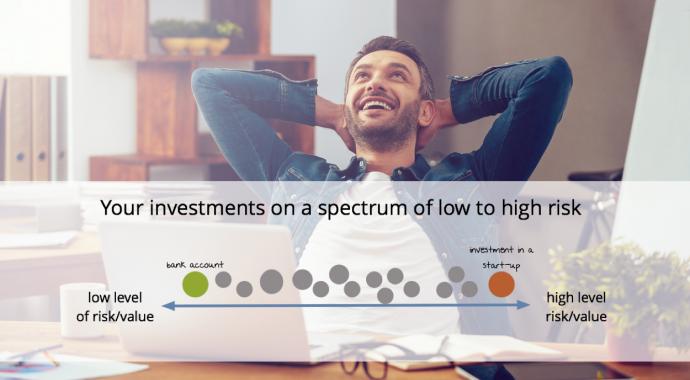
All investments come with levels of risk
The risks and corresponding levels of return on investment are correlated (what do I get for my investment). The lower the risk the less the return. The higher the risk the higher the return. These risks will be somewhere between the following two scenarios:
- Low-risk investment with low or negative return on investment - The investment is very safe but it doesn't appreciate in value very well (Example: your basic savings account - it may be safe but it also may not keep up with inflation so that you're losing purchase power in the long run).
- High-risk investment with expected high return on investment - The investment is very volatile and goes up or down very fast (Example: a mining company that thinks it has struck a valuable mineral and it goes up then finds out it was just a small amount that is not worth mining and the stock goes back down).
Your investment will have a risk level that is somewhere between these two scenarios.
The questions to answer are:
- How is this risk level determined? (Who determines it on which skill set and knowledge base?)
- How does the risk level pertain to your portfolio? (During different life phases and with differing amounts of money you have at your disposal, different levels of risk might make sense.)
There doesn't seem to be a simple easy way to get a risk evaluation for most investments. If you have a broker or financial planner, they will know the risk of an investment and how it pertains to your savings plan through their own experience. While bonds or GICs are generally safe, there are junk bonds which are very risky. There are utility stocks that are considered very safe then there are startup companies that are very risky. Each type of investment has safe to risky investments.
The idea of risk can be lowered by buying a variety of investments. This is called asset allocation. Buy some low risk, some medium risk, and some high risk. The amount of each risk will depend on the amount of risk tolerance a person has and the time period of saving. Don't put funds that you won't need for a long time into only super safe funds because they will not appreciate in value very well and don't buy all risky stocks (especially with funds you will need in the next years) as there are bound to be lots of losses.
Medium investments are good as they will likely appreciate well on average provided there is a bundle of them and that you own them for a fair amount of years. Buying an ETF or mutual fund would be ok if you agree with the investment choices in the ETF or Mutual Fund. For example, you may like to buy stocks of the largest companies in your country. You then need to find an ETF or mutual fund that has those stocks in the ETF or mutual fund. You might also prefer to buy stocks in utility-type companies as they are usually quite safe (they don't go up in value quite as well, but they are safer) so you need to find an ETF or mutual fund that has those kinds of stocks in them.
The other option is to buy an ETF or mutual fund that has a bit of everything in it so you have an all-round portfolio in one ETF or mutual fund. Just remember that one all-round ETF or mutual fund may not perform as well as another ETF or mutual fund. Each company runs their portfolios differently, therefore there are varying results.
To manage risk simply, ETFs and Mutual Funds are bundles of investments thus meaning there is a level of safety. It is more difficult for a Mutual Fund or ETF to be very volatile. At the same time, they create a level of asset allocation by being made of various investments.
If individual stocks are desired, then remember there is some risk in buying too many different stocks. Don’t spend a little bit on each stock and have too many different stocks. That means too much time is needed to watch over them. However, don't buy too few and risk a big investment being connected to only one or a small number of companies. If they fail, it then might lower your whole portfolio drastically.
